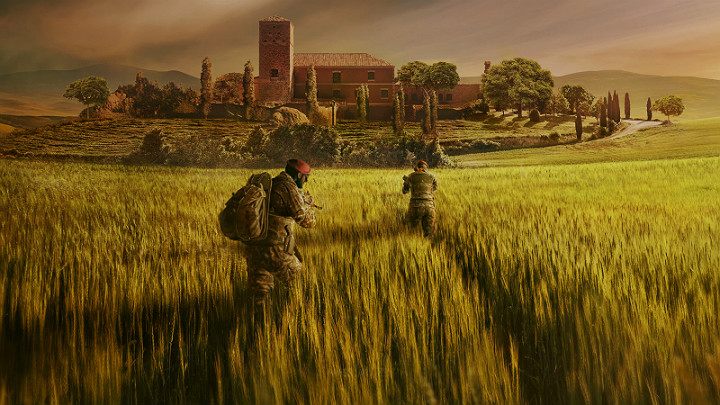Rainbow Six Siege: Video and audio settings
Last update:

Adapting the visual and sound settings of Tom Clancy's Rainbow Six: Siege to player's preferences can improve the comfort of playing and enable the player to obtain better results in the game. Below you can find all pieces of information that will help you with setting the graphics and sound settings of the game.
System Requirements for Tom Clancy's Rainbow Six: Siege
Minimum System Requirements for Tom Clancy's Rainbow Six: Siege:
- Operating System: 64-bit Windows 7 (SP1), Windows 8, Windows 10
- Video Card: NVIDIA GeForce GTX 670 / AMD Radeon HD 7870
- Processor: AMD Phenom II X4 945 3,0GHz / Intel Core i3-560 3,3GHz
- RAM: 6 GB
- Direct X: 11
Recommended System Requirements for Tom Clancy's Rainbow Six: Siege:
- Operating System: 64-bit Windows 7 (SP1), Windows 8, Windows 10
- Video Card: NVIDIA GeForce GTX 760 / AMD Radeon HD 7970 / R9 280X
- Processor: AMD FX-8120 2,6GHz / Intel Core i5-2500K 3,3GHz
- RAM: 8 GB
- Graphics Card VRAM: 2 GB
- Direct X: 11
Video settings
Tom Clancy's Rainbow Six: Siege was developed by using the AnvilNext engine created by Ubisoft. Despite the fact that AnvilNext was created a few years ago, the players can enter a very well recreated world with realistic shadows and lighting if they download Ultra HD texture pack. Weaker computers will have trouble with generating so good graphics, but if someone focuses on the gameplay and not on the graphics, then he or she doesn't need to use the enhanced textures. Tom Clancy's Rainbow Six: Siege can be enjoyed even on a hardware that barely meets the minimum system requirements - all that's needed to be done is to reduce proper graphics settings.
The variety of graphics options available in Tom Clancy's Rainbow Six: Siege enables the players to balance the quality of visuals and the fluency of the gameplay. Below you can find the list of graphics options that can be modified in order to find the best settings.
- Resolution - this option enables you to change the resolution of the game. Set the native resolution of your display to achieve a good quality of the graphics. Setting a lower resolution will generate more fuzzy visuals.
- Shadow Quality and Shading Quality - this option is responsible for the rendering of shadows of objects. The higher the resolution and the more the shadows, the more power of the GPU will be needed. You should reduce the quality of shadows in order to improve the fluency of the game.
- Anti-Aliasing - this option is responsible for smoothing the edges in the game. Owners of weaker graphics cards should consider deactivating this option.
- Drawing distance - this option determines the number of objects rendered at the same time. The higher the drawing distance, the more resources of the CPU and the GPU will be needed. If you want to improve playing comfort, consider lowering the value of this option.
- Texture Filtering - depending on the selected filter, you can obtain various levels of fuzziness, details and aliasing. On weaker configurations, you can deactivate additional graphics options in order to increase fluency of the game.
- LOD Quality - this option determines visual effects like display sharpening and it increases the quality of details. The higher the settings, the more power of the GPU is required.
- Reflection Quality - this option is responsible for creating subtle reflections, for example on wet surfaces and in pools.
- Ambient Occlusion - a shading method that increases the realism of the game. Sadly, it might cause great frame drops. In order to increase the fluency of the game, you should consider lowering the value of this parameter.
- Lens Effects- rendering effect that simulates real lens effects like reflections.
- Render Scaling - render scaling represents the resolution in which the game is rendered and then scaled to the selected screen resolution. For example, if render scaling is set to 50% (default value), then at 1920x1080 resolution it will render the game in 720p resolution and then scale it to 1080p. It will increase the fuzziness of the game while also increasing the fluency of the gameplay. This option is important for players using weaker computers. If you have a powerful hardware, you can set the render scaling to 100% and enjoy best possible display quality.
Audio settings
Tom Clancy's Rainbow Six: Siege, as every FPS game, depends strongly on audio. Many actions performed by the players can reveal their position and make them vulnerable to enemy attack. Because of that, during the game you should listen to your surroundings in order to determine from which side the enemy is coming and where the shots were fired, a bomb exploded or the enemy broke through fortifications. The first and most important thing is to use headset instead of speakers because of the following reasons:
- With a headset, you can be more focused on the game and other noise won't be interrupting you.
- Speaker sounds might be recorded by the microphone, worsening the quality of your communication with the team.
- Room acoustics might reduce the quality of speaker sound.
Additionally, it is important to make sure that the team can hear you well in voice chat. Therefore, check the microphone volume settings on your operating system and perform several tests, then adjust the sound level in the game's settings. Also, consider turning on the "press and talk" option so that there is no unwanted noise in the voice chat that could distract your team members, such as buzzing sounds on the fan or other sounds of your background. When the "press & talk" option is activated, you will first have to press the corresponding button and then communicate with the team.
You are not permitted to copy any image, text or info from this page. This site is not associated with and/or endorsed by the developers and the publishers. All logos and images are copyrighted by their respective owners.
Copyright © 2000 - 2025 Webedia Polska SA for gamepressure.com, unofficial game guides, walkthroughs, secrets, game tips, maps & strategies for top games.
